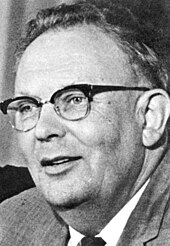Gerard Peter Kuiper
Gerard Peter Kuiper , actually Gerrit Pieter Kuiper (born December 7, 1905 in Harenkarspel , † December 24, 1973 in Mexico City ), last name spoken [ ˈkœypə ], was an American astronomer of Dutch origin. The Kuiper belt was named after him.
Life
Kuiper was the oldest of four children. His parents were Gerrit (a trained tailor ) and Antje nee de Vries. From 1924 he studied astronomy at the University of Leiden . In 1927 he successfully completed his bachelor's degree and immediately followed it up with his doctoral studies. Kuiper took part in an eight-month eclipse expedition to Sumatra in 1929 .
After studying at the University of Leiden and receiving a doctorate on double stars with Ejnar Hertzsprung , he went to the USA in 1933 and worked at the Yerkes Observatory at the University of Chicago from 1937 . In 1949 Kuiper initiated the Yerkes – McDonald Asteroid Survey (1950–1952). In 1960 he founded the Lunar and Planetary Laboratory at the University of Arizona .
Mainly he was concerned with the solar system . He detected the carbon dioxide in the atmosphere of Mars and discovered the atmosphere of Titan as well as the Uranus moon Miranda and the Neptune moon Nereid . He also worked theoretically on issues relating to the formation of the solar system and predicted the Kuiper belt that would be named after him .
Kuiper was also involved in finding suitable landing sites for the Apollo program by analyzing images from the lunar probes as the chief scientist of NASA's Ranger project in the 1960s .
Honors
- 1949: Member of the American Academy of Arts and Sciences
- 1950: Member of the National Academy of Sciences
- 1951: Kuiper received the Jules Janssen Prize from the French Astronomical Society.
- 1959: Kuiper was awarded the Henry Norris Russell Lectureship by the American Astronomical Society .
- 1971: Kuiper received the Kepler Gold Medal from the American Association for the Advancement of Science and the Franklin Institute .
- 1974: Kuiper is posthumously named after the Kuiper Scarp , a stepped terrain on Alexander I Island in Antarctica
- One crater on the moon , one on Mars and one on Mercury as well as the asteroid (1776) Kuiper bear his name, see also Kuiper Belt and Kuiper Belt Objects (KBO) .
- The Kuiper Airborne Observatory was named after him
- the American Astronomical Society's Gerard P. Kuiper Prize in Planetary Science was named in his honor.
Web links
- GP Kuiper publications in the Astrophysics Data System
- Obituaries for GP Kuiper in the Astrophysics Data System
literature
- Stars and Space, 4/2008
Individual evidence
- ^ Dale P. Cruikshank: Gerard Peter Kuiper (1905-1973). A Biographical Memoir. National Academy of Sciences, 1993. ( PDF )
- ^ Kuiper Crater on Mercury nasa.gov; NASA MESSENGER Image of Mercury: Kuiper Crater in Color spaceref.com, accessed December 11, 2015
| personal data | |
|---|---|
| SURNAME | Kuiper, Gerard Peter |
| ALTERNATIVE NAMES | Kuiper, Gerrit Pieter |
| BRIEF DESCRIPTION | American astronomer of Dutch descent |
| DATE OF BIRTH | December 7, 1905 |
| PLACE OF BIRTH | Harenkarspel |
| DATE OF DEATH | December 24th 1973 |
| Place of death | Mexico city |
